|
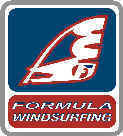
Improve
your stance
por Ian Fox
Fonte : www.bluefinz.com
You
are sailing along, trying to keep the
board from bouncing, your arms are aching,
feet are getting sore from the pounding.
Just when you think it could not get worse
someone whizzes by you, looking cool and
relaxed, going twice your speed.
What
magic is it that good sailors have? What
do they do that makes them faster, gybe
better, tire less? One word: stance. Other
things play a part of course, equipment
choice and setup and fitness among them,
but lets assume that those are taken care
of. What's left is just the way a sailor
uses his body.
Improving
your stance is the biggest leap you will
ever make in windsurfing. How does one
learn something so elusive and seemingly
personal? Careful observation of very good
windsurfers will show they all use their
body in a similar fashion and what I'll do
here is break down the differences between
an intermediate sailor and an expert.
two
sailors and their stance
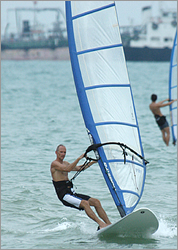 Lets
assume you've got to the stage where you
can use a harness comfortably and get in
the footstraps. At this stage most sailors
end up in the stance shown in this picture.This
is a picture of my good friend Edgar. He
progressed very fast in the early stages,
being a super fit cyclist and triathelete.
He's much further along in his skills now
than in this picture. Lets
assume you've got to the stage where you
can use a harness comfortably and get in
the footstraps. At this stage most sailors
end up in the stance shown in this picture.This
is a picture of my good friend Edgar. He
progressed very fast in the early stages,
being a super fit cyclist and triathelete.
He's much further along in his skills now
than in this picture.
 Now
lets look at another sailor. This is a
picture of Meng Wang, he's a member of
Team Bluefinz and an expert with many
years under his belt and is lethal in
formula competitions. He looks totally at
ease, yet this picture was taken just
seconds after the start of a race.
Comparing the stance of the two sailors is
very revealing. The biggest difference is
just one simple fact. Meng is hiked out
over the water, away from the board and
sail whereas Edgar has his weight over the
board. This "hiking out" is the
key, the very essence of a good stance! Now
lets look at another sailor. This is a
picture of Meng Wang, he's a member of
Team Bluefinz and an expert with many
years under his belt and is lethal in
formula competitions. He looks totally at
ease, yet this picture was taken just
seconds after the start of a race.
Comparing the stance of the two sailors is
very revealing. The biggest difference is
just one simple fact. Meng is hiked out
over the water, away from the board and
sail whereas Edgar has his weight over the
board. This "hiking out" is the
key, the very essence of a good stance!
why
the need to hike out?
When
you are sailing, the key forces you have
to cope with are:
- the
lift from the sail
- drag
from the board
- lift
& drag from the fin
The only
way to resist and control these forces is
through using your body weight. No matter
how strong you are, eventually you tire
and it becomes impossible to resist these
forces further. Using your body weight
effectively allows you to sail longer, go
faster and keep better control of the
board over the water.
If
you are not using your weight to
counterbalance the forces, then you are a
passenger, subject to the rig pulling you
around and the board bouncing you up and
down. If you hike out, and keep very light
and little weight on your feet, putting
all your weight in the harness, you are a
pilot, guiding and gliding the board and
rig without tiring easily.
A
stance is a complex thing, you are using
your body in three dimensions. In order to
understand how to improve this elusive
skill, we will break it down into
component parts using the stance of our
two friends Meng and Edgar.
arms,
shoulders and head
Look at
the two sailors carefully.
- Edgars
arms are very bent, taking alot of the
rigs force on the relatively weak
biceps muscle. Meng's arms are
straight and relaxed, even though he
is racing!
- Edgar's
shoulders are hunched in, Meng's
shoulders are rolled out. Just rolling
your shoulders can add about 6 to 8cm
of extra leverage.
- Edgar's
upper body is twisted in the direction
he is going, his back arm thus can't
come into play. Meng is square to the
sail, his shoulders and hips are
parallel to the center line of the
board, allowing him to use his body
weight to its maximum.
- The
most revealing of all: Meng's head is
twisted over his shoulder, looking
over his shoulder. Look at Edgar's
head. He is facing the way he is going,
opening up his entire body to a
forward direction instead of keeping
his knees, hips and shoulders parallel
to the sail.
The
end result is simple. All of Meng's
actions end up with his weight being taken
totally by the harness hook, allowing him
to keep his weight off the board, thereby
making the board skim lightly over the
water. His arms are relaxed and are used
to trim the sail to its optimum angle.
Edgar's
weight and the force of the rig is being
taken by his arms. Although he is probably
one of the fittest persons I have ever
known, no one can keep up that strain on
the arms for long. His weight is on the
board, making the board plough through the
water and feel bouncy.
So
what can Edgar do to improve his stance?
- first,
turn his body to face the sail so that
his shoulders and hips are parallel to
the board.
- turn
his head so that he now looks over his
shoulder.
- straighten
his arms so that they are relaxed.
- roll
his shoulders so that he gets longer
arms.
rolling
your shoulders
Many
people find this tip confusing. How do you
roll your shoulders? Look at this picture
sequence.
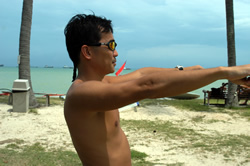 In
this picture the arms are outstretched in
a normal relaxed position, with the
shoulders held square In
this picture the arms are outstretched in
a normal relaxed position, with the
shoulders held square
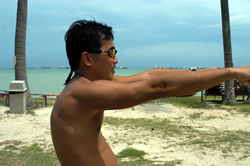 Here
the shoulders have been rolled back,
effectively lenghtening the leverage
distance between the body and the sail.
This is a significant difference and adds
considerably to the ability to keep the
rig under control. Here
the shoulders have been rolled back,
effectively lenghtening the leverage
distance between the body and the sail.
This is a significant difference and adds
considerably to the ability to keep the
rig under control.
If
you can't wriggle your fingers while
holding the boom, or hold the boom with
just your thumb and forefinger, then you
are not putting enough weight in your
harness. The forearm muscles are weak, so
learn to hold on to the boom lightly.
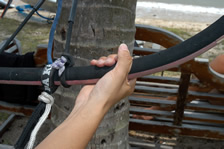 The front hand should hold the boom in an
underarm grip. This is much less tiring
than the overhand grip. Some expert
sailors use an overhand grip for upwind as
they run their harness lines well back on
the boom, but for general use this is the
best way to hold the boom with the front
hand.
The front hand should hold the boom in an
underarm grip. This is much less tiring
than the overhand grip. Some expert
sailors use an overhand grip for upwind as
they run their harness lines well back on
the boom, but for general use this is the
best way to hold the boom with the front
hand.
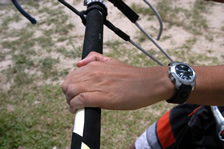 The
back hand should hold the boom such that
the wrist is in a straight line. When
cruising I keep the thumb of my back hand
on top of the boom. This simple move
serves to keep the forearm relaxed. To
sheet in, use your entire back and
shoulders, and not your biceps. I'll only
move my thumb to do a normal grip when
conditions are such that I really need
every ounce of control, otherwise, this
relaxed top of boom grip allows you to
effortlessly stay sheeted in for long
periods. The
back hand should hold the boom such that
the wrist is in a straight line. When
cruising I keep the thumb of my back hand
on top of the boom. This simple move
serves to keep the forearm relaxed. To
sheet in, use your entire back and
shoulders, and not your biceps. I'll only
move my thumb to do a normal grip when
conditions are such that I really need
every ounce of control, otherwise, this
relaxed top of boom grip allows you to
effortlessly stay sheeted in for long
periods.
lower
body, legs and feet
Lets
compare the two stance again, this time
focusing on the lower body. Meng's legs
are almost straight, with a slight bend to
the knees, to absorb and smoothen out the
ride of the board. Edgar's legs are bent,
bringing his weight inboard. Using his
feet Meng is able to trim the board flat.
The board thus rides more smoothly over
the water. Again, what are the actions
Edgar can take to improve his lower body
stance?
- hike
out in the harness, and straighten his
legs so that there is only a slight
bend in the knees.
- point
the toes, use the ball of the feet to
pressure the hull.
- keep
the weight off the heels as this tends
to sink the rail and prevent the board
from sailing flat.
putting
it all together
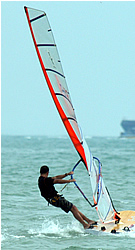
Look
carefully at Meng's sail. The foot of the
sail is held down to the deck, along the
central line of the hull. The entire sail
is held upright and exposed to the wind,
but sheeted in to get optimum drive. All
this has been achieved by his stance.
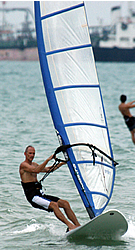
Look
at Edgar's sail. The sail is open, with
the foot of the sail well above the board.
The angle of the sail to the wind is very
open, thereby considerably reducing the
power the sail could generate. Just
changing his stance would result in the
sail automatically being sheeted in, to a
rig position similar to Meng's
Thus
there is one huge benefit to this stance
change. You automatically end up sheeting
in more, thus getting more power and drive
from the sail in a smoother manner. You go
faster, point better and get a much
smoother ride over the water. Once this
correct stance is achieved its alot easier
to begin to deal with the subtleties of
picking the correct path through the water
and keeping the rig as still as possible.
Lastly, learn to look way ahead and not
look at your sail and rig. Pick a path
through the water. Flex your knees to
absorb the big chop and straighten up to
drive the board faster through the flat
patches. Sail fast, sail smooth!
training
tips
All
this advice and pictures are well and good
but there must be a way to "dry run"
many of these improvements. For some time
now I've been using a "harness tree"
to help with stance improvement. This is
an old section of boom, with a harness
line, tied to a tree which allows sailors
to simulate loading the harness or
learning technique on how to use the
harness. Its a pretty easy set up to
create. Use a boom, rope and whatever
support structure you can find. The
gallery of pictures below shows you a
sequence you can work through to improve
your own stance. Below the gallery is a
picture of Kevin Pritchard in a perfect
stance. Be sure to look through it to
understand how the world champion does it.
drills
to help improve your stance

Legs
and arms are very bent, body is
hunched up to the boom, most of
the weight is on the feet. Body is
also twisted facing forward. Not
good!
|

The
first step: relax the arms and
lean your head and shoulders back.
Keep the arms straight and relaxed.
Consciously keep your shoulders
and hips parallel to the board,
avoid turning your body to face
forward.
|

Straighten
out your legs, keeping your entire
body relaxed. Feel your weight
pull against the harness hook.
|

Turn
your head now to look over
shoulder. This will prevent you
from turning your body forward. If
you turn your body forward your
back arm will bend and you will
never be able to naturally fully
sheet in.
|

Rise
up on your toes. You should trim
and pressure the board with the
toes and balls of your feet.
Putting your heels down tends to
force your weight down on the
board. Experment with rising and
lowering on your toes, you will be
suprised at how much more force
you can exert by merely rising up
on your toes.
|

Here's
a fun exercise to do. Hang all
your weight from the harness, lean
as far back as you can and put
your hands behind your head. This
will force all of your weight on
to the harness hook. This will
give you some idea of just how
much power you can generate to
control your sail merely by
applying your weight to the
harness. Good sailors can do this
trick on the water, flying along
without holding the boom.
|
a
world champion's stance
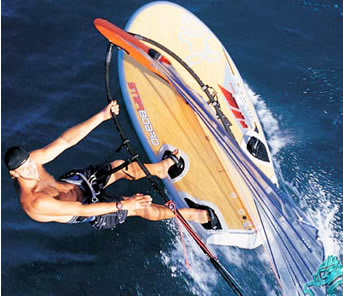
Lets
look at how world champion Kevin Pritchard
does it. Draw a line through the middle of
the board from its front to rear and you
will notice that:
- his
hips,shoulders, knees and ankles are
parallel to that line
- his
shoulders are rolled out, with his
arms relaxed.
- body
weight is hiked out way out over the
water, with feet light on the board.
- harness
lines are long and well back on the
boom to allow for hiking out and using
the body weight to sheet in.
- he
is neither leaning too far forward or
back, he is square to the board,
effortlessly using his weight to sheet
in
- feet
are driving the board, look at the
angle of his back foot.
- the
sail is planted down on the deck,
perfectly aligned along the line drawn
through the middle of the board.
Effortless.
Elegant. Powerful. This is the aim of a
perfect stance.
|

